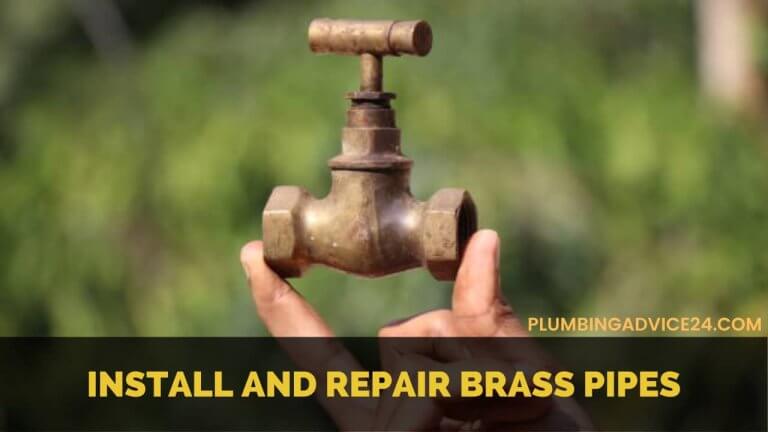What Is Brass Pipe | Brass Plumbing Pipe Size
It is a good idea to use brass in plumbing pipes. The advantages and disadvantages of brass plumbing pipes are similar to those of copper pipes, as they are made from a mixed alloy of copper and zinc, with a high content of copper. The brass plumbing pipe has good longevity besides giving a beautiful look to the house.
This article will discuss brass pipe, including what a brass pipe is. How it is made, how long it lives, where it is used, how it can be measured, how much it costs, and its advantages and disadvantages, etc.
What Is Brass Pipe?
Brass plumbing pipes are generally made from an alloy containing copper and zinc. These pipes are made of 67 percent to 85 percent copper, making them pipes with great rust resistance.
When the alloy contains 85 percent copper, it is called a red brass pipe. The red brass pipe, also known as alloy 230 or alloy UNS number C23000, is the best. Brass piping can last for a long time and does not corrode its interior.
Brass pipes are more expensive than iron or galvanized pipes, but because they lack many of the advantages of brass pipes, they can be bent or threaded as easily as steel pipes.
Hot water corrodes steel pipes faster than cold water, making brass pipes better in these conditions. Brass pipes on hot water lines do not give the water a red color like steel pipes. Brass pipe is one of the longest-lasting plumbing materials.
Must Read : What Is Plumbing Pipe | 22 Different Types of Plumbing pipes
How Is Brass Pipe Made?
Brass pipes are made from an alloy of brass. The appropriate amount of copper alloy is weighed and transferred to an electric furnace. Where it is melted at about 1,920°F (1,050°C). After adjusting the amount of zinc in this alloy, an appropriate amount of zinc is added after the copper is melted. It is then cooled, and a brass alloy is formed.
The following steps are considered for making brass pipes.
- The brass alloy is transferred to an electric furnace and melted by proper heating.
- Once the brass alloy has melted and liquefied, it is cast into a pipe-shaped die.
- This die is cooled by the cold rolling method.
- After cooling, the pipe is taken out of the die and cut to the desired length of the brass pipe.
Must Read : What Is Plumbing Pipe Materials | What Is Used to Make Plumbing Pipes
Brass Pipe Lifespan
Brass is highly resistant to corrosion. Rust and corrosion accelerate the natural wear and tear process on fittings, so brass is the best material for the job when you’re looking for a long-lasting pipe.
Regardless of the material, this is the lifespan of every plumbing pipe you should know so you can gauge whether you need an upgrade. Brass pipes generally have a lifespan of 80 to 100 years.
Must Read : What Is a Copper Pipe | Types of Copper Pipes | Copper Pipe Cost | How to Measure Copper Pipe Size
What Is Brass Pipe Used For?
Brass is the most commonly used material for making pipes and fittings. Zinc and copper alloys have been used for centuries because of their unique properties, making them a good choice for various applications. In modern times, brass is most commonly used in pipes and fittings used in plumbing.
Brass Plumbing pipes and fittings are often the choices of plumbers and other construction professionals due to their dynamic properties. It is more durable and flexible than other material options and is resistant to corrosion.
The brass plumbing pipe can be found especially in older homes and is used for water supply, drainage, and gas lines. Modern homes usually have copper updates, but brass piping is still relevant to the industry.
Brass pipes are excellent for plumbing and oil, gas, and steam applications, pump fittings, water tanks, wells, and hot water distribution lines.
Must Read : What Is Pipe Fittings | 12 Types of Pipe Fittings
How to Measure Brass Pipes?
First, check if your pipe has “male” or “female” threads or no threads. Threads are small grooves on the ends of some pipes that help them fit together. Male threads are on the outside of the pipe, while female threads are on the inside.
If there are male threads or no threads, measure the brass pipe by the following method.
- Place one end of the string over the pipe and wrap it around the pipe.
- Note the measurement at which the string touches the end of a round pipe again.
- Measure the length between the top of the string and the mark you made (the circumference) using a ruler or measuring tape.
- Divide this measurement by 3.14159 and record the measurement, and then check in the table.
If there are female threads, measure the brass pipe by the following method.
- Map the inside of the brass pipe using a ruler, measuring tape, or caliper.
- With a measuring tape or ruler at one end of the pipe, note the measurement from the center of the pipe to the opposite end, which is the diameter of the pipe.
- Check the table below after recording the measurements.
Brass Pipe Size Chart
The following table is for male threads and female threads of brass pipe:
| BRASS PIPE FITTING SIZE CHART FOR THREADED | |||||
| Nominal Size | Thread Pitch | MaleThread Outer Diameter (mm) | Male Thread Outer Diameter (inches) | Female Thread Inside Diameter (mm) | Female Thread Inside Diameter (inches) |
| 1/8 | 27 | 10.3 | 0.41 | 9.4 | 0.37 |
| 1/4 | 18 | 13.7 | 0.54 | 12.4 | 0.49 |
| 3/8 | 18 | 17.3 | 0.68 | 15.7 | 0.62 |
| 1/2 | 14 | 21.3 | 0.84 | 19.3 | 0.76 |
| 5/8 | 14 | 22.9 | 0.90 | 21.1 | 0.83 |
| 3/4 | 14 | 26.9 | 1.06 | 24.9 | 0.98 |
| 1 | 11 1/2 | 33.3 | 1.31 | 31.5 | 1.24 |
| 1 1/2 | 11 1/2 | 42.2 | 1.66 | 40.1 | 1.58 |
| 1 1/2 | 11 1/2 | 48.3 | 1.90 | 46.2 | 1.82 |
| 2 | 11 1/2 | 60.4 | 2.38 | 57.9 | 2.29 |
Must Read : What is Plumbing Tools | 31 Types of Plumbing Hand Tools
How Much Does Brass Pipe Cost?
Brass pipes are suitable for many residential and industrial plumbing needs. While they cost a little more, they are not significantly more expensive than other options. Their durability, reliability, and quality can save you many dollars in brass pipe repairs over other pipes.
Brass materials have a high aesthetic quality because of their strong resemblance to gold. Additionally, the addition of zinc makes this material stronger than copper. Brass pipe costs about $7 to $15 a linear foot. The price of brass pipe can vary depending on the thickness and quality of the pipe.
Must Read : What Is Plumbing Trap | 15 Different Types of Plumbing Traps
Advantages of Brass Pipe
- Brass pipe is used in both residential and industrial plumbing due to its excellent durability and heavy-duty use.
- It is highly resistant to corrosion. So it does not get damaged for a long time, and it is the best option as a drinking water distribution line.
- Brass pipes can withstand high temperatures, so they are also used as hot water distribution lines.
- Brass pipes are resistant to attack by salt water and acids.
- Brass pipes are easy to install, thus saving your labor costs.
- Brass pipes are fire-resistant, so they are not damaged when exposed to combustible materials.
Disadvantages of Brass Pipe
- Brass is made from an alloy of copper and zinc. Zinc in brass pipes is periodically converted to zinc oxide, which forms a white powder that sticks to pipes and fixtures.
- Brass pipes are prone to blackish tarnishing, so they require maintenance from time to time.
- Brass pipes are more expensive pipes than other pipes.
What Is Red Brass Tubing?
Brass tubing is made of 67 percent to 85 percent copper. The alloy contains 85 percent copper, called red brass tubing. The red brass tubing, also known as alloy 230 or alloy UNS number C23000, is the best. Brass piping can last long and does not corrode its interior.
Can You Use Brass Pipe for Water?
The simple answer to this question is yes. Brass pipes can be used for drinking water lines. It is more durable and corrosion-resistant than other pipe materials. As it offers exceptional temperature conductivity, it is considered ideal for use as a hot water distribution line.
How Long Do Brass Pipes Last?
Brass is highly resistant to corrosion. Rust and corrosion accelerate the natural wear and tear process on fittings, so brass is the best material for the job when you’re looking for a long-lasting pipe. Brass pipes generally have a lifespan of 80 to 100 years.
Is Brass Good for Plumbing?
Brass is a pipe material that is resistant to corrosion and has good longevity, making it ideal for use in plumbing applications. Due to the corrosion resistance properties of brass pipes, they are preferred in areas with high corrosive water quality.
What Are Brass Pipes Used For?
The brass pipe can be found especially in older homes and is used for water supply, drainage, and gas lines. Modern homes usually have copper updates, but brass piping is still relevant to the industry. Brass pipes are excellent for plumbing and oil, gas, and steam applications, pump fittings, water tanks, wells, and hot water distribution lines.
If You Liked This Post? So Share It with Your Friends
Suggested Articles:
- What Is a PVC Pipe | How to Measure PVC Pipe Size | PVC Pipe Installation Cost
- What is PEX Pipe | PEX Pipe Applications | How to Measure PEX Pipe | PEX Pipe Installation Cost
- What is CPVC Pipe | CPVC Pipe Manufacturing Process | CPVC Pipe Applications | How to Measure CPVC Pipes | CPVC Pipe Cost
- What is uPVC Pipe | uPVC Pipe Manufacturing Process | uPVC Pipe Applications | How to Measure uPVC Pipes | uPVC Pipe Cost
- What Is Polyethylene Pipe | Poly Pipe Manufacturing Process | PE Pipe Applications | How to Measure PE Pipe | PE Pipe Cost














